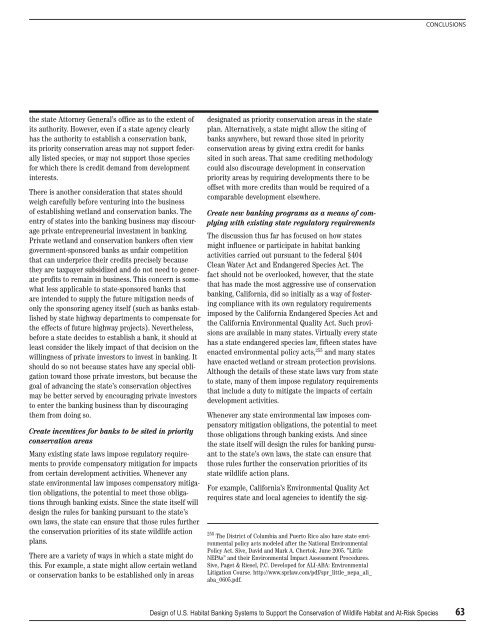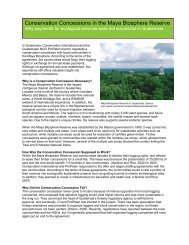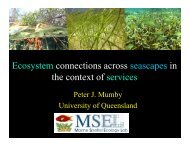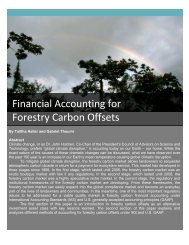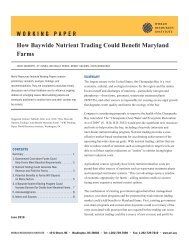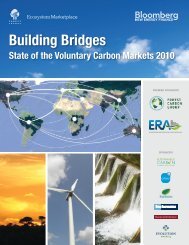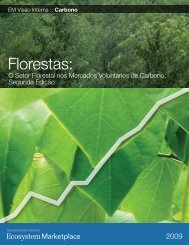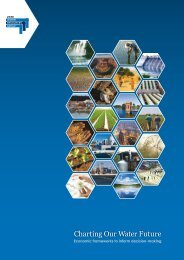Design of US Habitat Banking Systems to Support the Conservation ...
Design of US Habitat Banking Systems to Support the Conservation ...
Design of US Habitat Banking Systems to Support the Conservation ...
You also want an ePaper? Increase the reach of your titles
YUMPU automatically turns print PDFs into web optimized ePapers that Google loves.
CONCL<strong>US</strong>IONS<strong>the</strong> state At<strong>to</strong>rney General’s <strong>of</strong>fice as <strong>to</strong> <strong>the</strong> extent <strong>of</strong>its authority. However, even if a state agency clearlyhas <strong>the</strong> authority <strong>to</strong> establish a conservation bank,its priority conservation areas may not support federallylisted species, or may not support those speciesfor which <strong>the</strong>re is credit demand from developmentinterests.There is ano<strong>the</strong>r consideration that states shouldweigh carefully before venturing in<strong>to</strong> <strong>the</strong> business<strong>of</strong> establishing wetland and conservation banks. Theentry <strong>of</strong> states in<strong>to</strong> <strong>the</strong> banking business may discourageprivate entrepreneurial investment in banking.Private wetland and conservation bankers <strong>of</strong>ten viewgovernment-sponsored banks as unfair competitionthat can underprice <strong>the</strong>ir credits precisely because<strong>the</strong>y are taxpayer subsidized and do not need <strong>to</strong> generatepr<strong>of</strong>its <strong>to</strong> remain in business. This concern is somewhatless applicable <strong>to</strong> state-sponsored banks thatare intended <strong>to</strong> supply <strong>the</strong> future mitigation needs <strong>of</strong>only <strong>the</strong> sponsoring agency itself (such as banks establishedby state highway departments <strong>to</strong> compensate for<strong>the</strong> effects <strong>of</strong> future highway projects). Never<strong>the</strong>less,before a state decides <strong>to</strong> establish a bank, it should atleast consider <strong>the</strong> likely impact <strong>of</strong> that decision on <strong>the</strong>willingness <strong>of</strong> private inves<strong>to</strong>rs <strong>to</strong> invest in banking. Itshould do so not because states have any special obligation<strong>to</strong>ward those private inves<strong>to</strong>rs, but because <strong>the</strong>goal <strong>of</strong> advancing <strong>the</strong> state’s conservation objectivesmay be better served by encouraging private inves<strong>to</strong>rs<strong>to</strong> enter <strong>the</strong> banking business than by discouraging<strong>the</strong>m from doing so.Create incentives for banks <strong>to</strong> be sited in priorityconservation areasMany existing state laws impose regula<strong>to</strong>ry requirements<strong>to</strong> provide compensa<strong>to</strong>ry mitigation for impactsfrom certain development activities. Whenever anystate environmental law imposes compensa<strong>to</strong>ry mitigationobligations, <strong>the</strong> potential <strong>to</strong> meet those obligationsthrough banking exists. Since <strong>the</strong> state itself willdesign <strong>the</strong> rules for banking pursuant <strong>to</strong> <strong>the</strong> state’sown laws, <strong>the</strong> state can ensure that those rules fur<strong>the</strong>r<strong>the</strong> conservation priorities <strong>of</strong> its state wildlife actionplans.There are a variety <strong>of</strong> ways in which a state might dothis. For example, a state might allow certain wetlandor conservation banks <strong>to</strong> be established only in areasdesignated as priority conservation areas in <strong>the</strong> stateplan. Alternatively, a state might allow <strong>the</strong> siting <strong>of</strong>banks anywhere, but reward those sited in priorityconservation areas by giving extra credit for bankssited in such areas. That same crediting methodologycould also discourage development in conservationpriority areas by requiring developments <strong>the</strong>re <strong>to</strong> be<strong>of</strong>fset with more credits than would be required <strong>of</strong> acomparable development elsewhere.Create new banking programs as a means <strong>of</strong> complyingwith existing state regula<strong>to</strong>ry requirementsThe discussion thus far has focused on how statesmight influence or participate in habitat bankingactivities carried out pursuant <strong>to</strong> <strong>the</strong> federal §404Clean Water Act and Endangered Species Act. Thefact should not be overlooked, however, that <strong>the</strong> statethat has made <strong>the</strong> most aggressive use <strong>of</strong> conservationbanking, California, did so initially as a way <strong>of</strong> fosteringcompliance with its own regula<strong>to</strong>ry requirementsimposed by <strong>the</strong> California Endangered Species Act and<strong>the</strong> California Environmental Quality Act. Such provisionsare available in many states. Virtually every statehas a state endangered species law, fifteen states haveenacted environmental policy acts, 255 and many stateshave enacted wetland or stream protection provisions.Although <strong>the</strong> details <strong>of</strong> <strong>the</strong>se state laws vary from state<strong>to</strong> state, many <strong>of</strong> <strong>the</strong>m impose regula<strong>to</strong>ry requirementsthat include a duty <strong>to</strong> mitigate <strong>the</strong> impacts <strong>of</strong> certaindevelopment activities.Whenever any state environmental law imposes compensa<strong>to</strong>rymitigation obligations, <strong>the</strong> potential <strong>to</strong> meetthose obligations through banking exists. And since<strong>the</strong> state itself will design <strong>the</strong> rules for banking pursuant<strong>to</strong> <strong>the</strong> state’s own laws, <strong>the</strong> state can ensure thatthose rules fur<strong>the</strong>r <strong>the</strong> conservation priorities <strong>of</strong> itsstate wildlife action plans.For example, California’s Environmental Quality Actrequires state and local agencies <strong>to</strong> identify <strong>the</strong> sig-255 The District <strong>of</strong> Columbia and Puer<strong>to</strong> Rico also have state environmentalpolicy acts modeled after <strong>the</strong> National EnvironmentalPolicy Act. Sive, David and Mark A. Cher<strong>to</strong>k. June 2005. ”LittleNEPAs” and <strong>the</strong>ir Environmental Impact Assessment Procedures.Sive, Paget & Riesel, P.C. Developed for ALI-ABA: EnvironmentalLitigation Course. http://www.sprlaw.com/pdf/spr_little_nepa_ali_aba_0605.pdf.<strong>Design</strong> <strong>of</strong> U.S. <strong>Habitat</strong> <strong>Banking</strong> <strong>Systems</strong> <strong>to</strong> <strong>Support</strong> <strong>the</strong> <strong>Conservation</strong> <strong>of</strong> Wildlife <strong>Habitat</strong> and At-Risk Species 63


